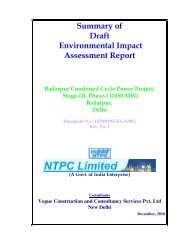EIA Studies of 3 Pre-Identified Hazardous Waste Disposal Sites in ...
EIA Studies of 3 Pre-Identified Hazardous Waste Disposal Sites in ...
EIA Studies of 3 Pre-Identified Hazardous Waste Disposal Sites in ...
Create successful ePaper yourself
Turn your PDF publications into a flip-book with our unique Google optimized e-Paper software.
Rapid <strong>EIA</strong> <strong>Studies</strong> <strong>of</strong> 3 <strong>Pre</strong>-identified <strong>Hazardous</strong> <strong>Waste</strong> <strong>Disposal</strong> <strong>Sites</strong> <strong>in</strong> NCT - Delhi:<br />
Page No.59<br />
alluvial deposits are grey coloured sands conta<strong>in</strong><strong>in</strong>g m<strong>in</strong>or proportions <strong>of</strong> f<strong>in</strong>es i.e. silt<br />
and clay. These deposits are generally characterised by the absence <strong>of</strong> kankar.<br />
Newer alluvium at some places consists <strong>of</strong> coarse gravel which is irregular and<br />
poorly sorted <strong>in</strong> nature. The older alluvium consists <strong>of</strong> <strong>in</strong>ter-bedded, lenticular and<br />
<strong>in</strong>ter f<strong>in</strong>ger<strong>in</strong>g deposits <strong>of</strong> clay, silt and sand rang<strong>in</strong>g <strong>in</strong> size from very f<strong>in</strong>e to medium<br />
textured. Kankar which is generally hard, compact and irregular occurs mixed with<br />
almost all these deposits. Older alluvium is predom<strong>in</strong>antly clayey <strong>in</strong> nature.<br />
Sub-surface Geology<br />
There are possibilities <strong>of</strong> fresh groundwater aquifers <strong>in</strong> this area as per Central<br />
Ground Water Board's f<strong>in</strong>d<strong>in</strong>gs. Sand, medium to coarse gra<strong>in</strong>ed, admixed with<br />
vary<strong>in</strong>g proportions <strong>of</strong> Kankar horizons dom<strong>in</strong>ates at shallow depths <strong>in</strong> and act as<br />
moderately potential aquifer zones. These sand horizons <strong>of</strong> vary<strong>in</strong>g thickness from 3<br />
to 15 m are predom<strong>in</strong>ant upto a depth <strong>of</strong> about 70 to 75 m at Bawana, 112 m at<br />
sanoth and up to 88 m <strong>in</strong> Barwala. Th<strong>in</strong> clay layers <strong>of</strong> about 5 to 10 m thick separate<br />
these sand bodies. At Putkhurd the sand horizons <strong>of</strong> 5 to 10 m thick are separated<br />
by clay layers <strong>of</strong> about 3 to 15 m thick. At Holambi kalan the sand bodies <strong>of</strong> about 5<br />
to 20 m thick up to a depth <strong>of</strong> 86 m are separated by clay layer <strong>of</strong> about 5 to 7 m<br />
thick. The clay horizons are <strong>in</strong>variably present after 80 to 112 m and seems to<br />
persists to considerable depth. The sub-surface geology across the section <strong>of</strong><br />
Sanoth to Khera Kalan shows that newer alluvium is present <strong>in</strong> southern part with<br />
depth rang<strong>in</strong>g up to 20 m at Khera Kalan. At Sanoth, the older alluvium consist<strong>in</strong>g <strong>of</strong><br />
silty sand mixed with kankar is present up to a depth <strong>of</strong> 84 m and at Khersa kalan it<br />
is up to a depth <strong>of</strong> 70 m. Below this horizon, alluvium is predom<strong>in</strong>antly clayey mixed<br />
with kankar and m<strong>in</strong>or silt is present. Five to six <strong>in</strong>tercalations <strong>of</strong> silty sand mixed<br />
with kankar horizons are present as lenses with<strong>in</strong> the clayey horizons. Thickness <strong>of</strong><br />
these lenses is 5-7 m.<br />
Around Site II: Wazirpur CETP site<br />
Wazirpur Industrial area is occupied by Quaternary Alluvium underla<strong>in</strong> by the Alwar<br />
Quartzites <strong>of</strong> Delhi System. Thickness <strong>of</strong> alluvium is more than 300 m <strong>in</strong> this part <strong>of</strong><br />
Delhi. Alluvium consists <strong>of</strong> predom<strong>in</strong>antly silt and kankar mixed with m<strong>in</strong>or amounts<br />
<strong>of</strong> clay. Silt mixed with kankar that acts as very good aquifer system <strong>in</strong> the area<br />
usually extends <strong>in</strong>-between the depth <strong>of</strong> 25 to 30 m. Good aquifer system extend<strong>in</strong>g<br />
from 40 to 50 m depth consists <strong>of</strong> predom<strong>in</strong>antly kankar with m<strong>in</strong>or silt is present <strong>in</strong><br />
the area.<br />
Around Site III: Guman Hera CETP site<br />
The area is underla<strong>in</strong> by older alluvium ma<strong>in</strong>ly consists <strong>of</strong> unconsolidated, <strong>in</strong>ter<br />
bedded sand, clay and silt mixed with vary<strong>in</strong>g proportions <strong>of</strong> gravel and kankar. The<br />
top horizon is predom<strong>in</strong>antly sandy silt mixed with kankar extends down to a depth <strong>of</strong><br />
30m. This layer is followed by predom<strong>in</strong>antly clay layer at deeper levels. Th<strong>in</strong><br />
granular zones consist<strong>in</strong>g <strong>of</strong> silt and kankar are also present with <strong>in</strong> the clay layer<br />
extend<strong>in</strong>g from 30 to 50 m depth. Thickness <strong>of</strong> these granular zones are <strong>in</strong>creas<strong>in</strong>g<br />
towards Najafgarh dra<strong>in</strong>. Ground water occurs as unconf<strong>in</strong>ed condition <strong>in</strong> sandy silt<br />
horizon which are potential aquifers <strong>in</strong> the area.<br />
Environment Division, National Productivity Council, New Delhi<br />
4
















